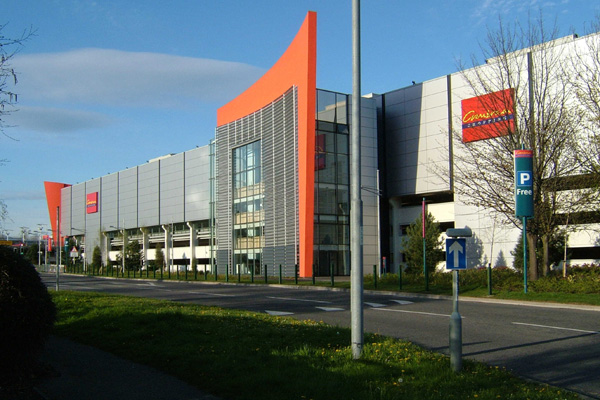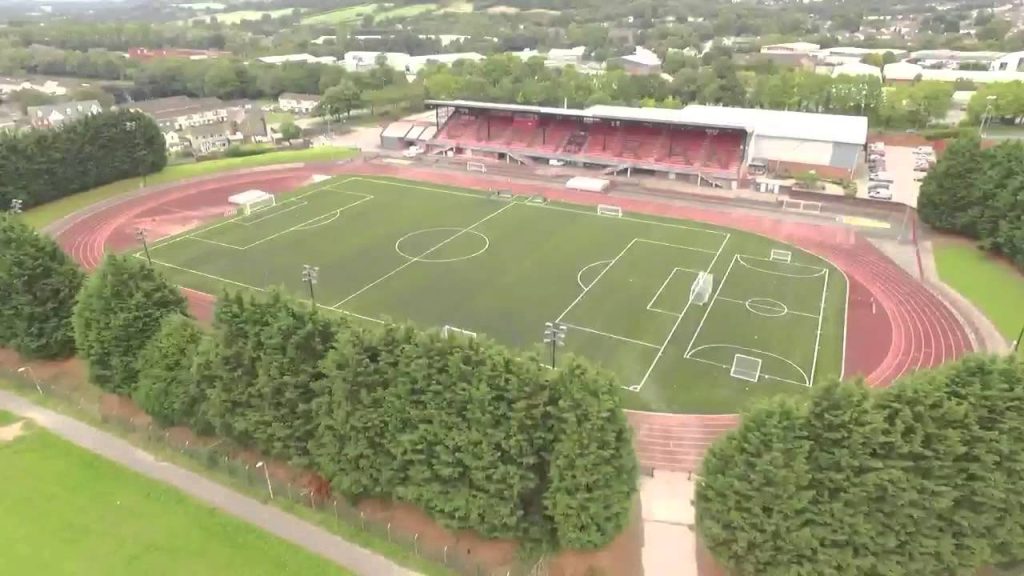Cwmbran

CWMBRAN is located in the south-east corner of Wales, around 20 miles from the capital city of Cardiff. It is unique in the region, as it is the first and only designated ‘new town’ in south Wales. Since its designation, the town has grown and developed and is now a thriving location, with around 50,000 inhabitants.
Lying within the historic boundaries of Monmouthshire, Cwmbran was designated as a new town in 1949 to provide fresh employment opportunities in the south-eastern portion of the south Wales coalfield.
Industry and employment has prospered in the town. Cwmbran has a solid manufacturing base, with particular strengths in engineering, together with automotive and electronic component manufacture. Increasingly, IT and information-related industries are being targeted. Llantarnam Park, to the south of the town centre, is one of the region’s most prestigious industrial locations. It is home to a number of prominent companies such as Loseley, Hempel and Spear Europe.
Cwmbran has also prospered from having a vibrant retail core. The shopping centre is fully pedestrianised with covered shopping malls.
Comprising the villages of Old Cwmbran, Pontnewydd, Upper Cwmbran, Henllys, Croesyceiliog, Llantarnam and Llanyrafon, its population had grown to 48,535 by 2011 making it the sixth largest urban area in Wales.
Sitting as it does at the corner of the south Wales coalfield, it has a hilly aspect to its western and northern edges, with the surrounding hills climbing to over 1,000 feet (300m). The Afon Llwyd forms the major river valley, although the most significant water course is probably the remains of the Monmouthshire & Brecon Canal. To the east of Cwmbran the land is less hilly, forming part of the Usk valley.
Cwmbran was the name of one of several villages located in the valley, which had grown up around the tinplate works of the Cwmbran Iron Company. As the new town of Cwmbran was formed in 1949, the area of the old village became known as Old Cwmbran.
There is evidence that Neolithic and Bronze Age people used the area, with the Iron Age Silures tribe also occupying the region before being subdued by the Roman legions based at nearby Usk and Caerleon.
Around 1179, Hywel, Lord of Caerleon gave a gift of money and land to found the Cistercian abbey at Llantarnam. At the dissolution of the monasteries by Henry VIII the abbey was closed and was bought by a succession of wealthy landowners.
By the 18th Century, the abbey had passed into the ownership of the Blewitt family, who were to become key figures in the early industrialisation of Cwmbran. Brick making, lime kilns, iron ore mining, quarrying and coal mining were established during this period, along with a canal to transport goods to the docks at Newport.

In 1833, the Ordnance Survey map of Monmouthshire shows Cwmbran as a farm situated in the area now known as Upper Cwmbran, in the valley named Cwm Brân. Cwmbran now covers about 3,000 acres.
Following some investigation by local residents Richard Davies and Mike Price, the Ancient Cwmbran & The Cistercian project was created and a £48,000 grant was provided by the Heritage Lottery Fund to explore some previously unrecorded sites of interest in the Greenmeadow and Thornhill areas.
The Cistercian Way also passes through Llantarnam, Old Cwmbran, Greenmeadow and Thornhill before reaching the ancient chapel of Llanderfel on Mynydd Maen, and then onwards to Twmbarlwm.
In the 19th and 20th centuries, Cwmbran was the site of heavy industrial development. Coal and iron ore were extracted on Mynydd Maen, and moved by inclined planes and tramways into the Eastern Valley for use in factories such as the Patent Nut and Bolt Company (which became Guest Keen and Nettlefolds in 1900), various tin plate works and brickworks.
This industry drove the creation of the Monmouthshire Canal, the Newport and Pontypool Railway and the Pontypool, Caerleon and Newport Railway. Very little of this industrial heritage remains today, though many of today’s light industrial or retail estates were created on the sites.
Following the 1946 New Towns Act, ministries and county councils were asked to nominate sites for housing. For Wales, the Ministry of Housing and Local Government proposed Church Village and Cwmbran. The Church Village proposal was vetoed by the Ministry of Power as new housing there would have interfered with plans for the expansion of coal mining in the area; however, Cwmbran was passed in 1949.
Cwmbran was a civil parish and, from 1974, a community in its own right, one of only five in the new district of Torfaen. In 1985, the Cwmbran community was abolished, replaced by Cwmbran Central, Fairwater, Llantarnam, Pontnewydd and Upper Cwmbran.
The longest established employer in Cwmbran is biscuit maker Burton’s Foods, who employ 1,000 people to make its Jammie Dodgers and Wagon Wheels biscuits. As of 2005, the Cwmbran plant produced over 400 million Wagon Wheels a year.
Safran Seats Great Britain (formerly Zodiac Aerospace) is the owner of a factory in Cwmbran which employs 1,000 people for manufacturing aircraft seats.
Constructed from 1959 to 1981, the pedestrianised Cwmbran Centre hosts supermarkets, high street retailers, banks, theatre, cinema, bowling alley, restaurants, creche, trampoline park, gym, police station, magistrates court, youth centre, pub, library, arts centre and office space. The 170+ shops can be accessed by the bus station located in the Centre, a train station a few minutes walk north-east or with the 3,000 free parking spaces located around the Centre’s ring road.
SME-businesses include the Cwmbran Brewery in Upper Cwmbran, which opened in 1996 as Cottage Spring Brewery.
The town has two secondary education schools – Croesyceiliog School and Cwmbran High School. There are numerous primary and nursery schools including a Welsh medium primary school, Ysgol Gymraeg Cwmbrân.
Cwmbran Stadium was home to international athletics events in the 1970s and 1980s. British athletics coach Malcolm Arnold used to train some of his athletes at Cwmbran in the ’80s and early ’90s while he was the Welsh National Coach.
Athletes who trained there regularly under Malcolm include former world 110m hurdles champion and world record holder Colin Jackson, Commonwealth 110m hurdle medallist, Paul Gray, and Nigel Walker who had two sporting careers, first as an Olympic hurdler and then later as a Welsh rugby union international player.
The 1999 World Indoor 400m champion Jamie Baulch used the stadium as a regular training track under a different coach. The stadium is also the home of Gwent Hockey Club (men’s and ladies).
The town has three athletics clubs: Cwmbran Harriers, Fairwater Runners and Griffithstown Harriers.
The three main football teams in Cwmbran are Cwmbran Town, Cwmbran Celtic and Croesyceilog who all compete in the Welsh Football League. Cwmbran Town and Celtic both play at Cwmbran Stadium. Also in Cwmbran was The Football Factory. Located near to the town centre, The Football Factory was an indoor sports complex consisting of two sports pitches. The building was destroyed by fire in February 2017.

Separate grounds at Pontnewydd and Croesyceiliog house the town’s two rugby union teams, Cwmbran RFC and Croesyceiliog RFC, although many more of the town’s residents support the rugby teams of the older, adjacent town of Pontypool, Newport and the Newport Gwent Dragons regional team.
Rugby League is represented in the town by Torfaen Tigers, who play in the fourth tier of the pyramid system, the Conference League South. They play their home matches at the Kings Head Ground, home of Cwmbran RFC.
The main newspaper in the region is the South Wales Argus and the semi-national Western Mail. The digital edition of the latter is published as Wales Online. The town is served by a local news service, Cwmbran Life, while the BBC also serve the south-east Wales region from their base in Cardiff.
A number of online and amateur radio stations operate in Cwmbran. Vitalize Radio operates as the community radio station for Torfaen, originally established in 2014 as Torfonix. There are also the Cwmbran and District Amateur Radio Society, and Able Radio, who support adults with autism and learning disabilities.
In July 2011, Cwmbran was the setting for Goldie Lookin Chain’s satirical Fresh Prince of Cwmbran, a song based on the Fresh Prince of Bel-Air theme, praising the town.
Cwmbran railway station is served by trains on the Welsh Marches Line, with through trains south to Newport and Cardiff. Northbound local trains serve Pontypool and Abergavenny, and longer distance services run to Hereford, Shrewsbury, Crewe, Holyhead and Manchester. The station was not opened until 1986, as one of the last acts of the Cwmbran New Town Development Board.
Until then, Cwmbran had had no train service for 24 years. Historically, Cwmbran was served by two lines and several local stations. The first line was built by the Monmouthshire Railway and Canal Company and opened in 1852 (much of its route is now under Cwmbran Drive, the A4051). The line that is still in use was opened by the Pontypool, Caerleon and Newport Railway in 1874.
The town has a comprehensive local bus service from Cwmbran bus station. Stagecoach South Wales operate the majority of services at Cwmbran. Phil Anslow Coaches are a local coach company who also run services in the town.
Cwmbran is partnered with Bruchsal in Baden-Württemberg, Germany.
Notable people from the area include:
John Williams (VC) (born 1857, died 1932) – real name John Fielding, Zulu War and Rorke’s Drift veteran, born in Abergavenny, buried in Llantarnam.
Ivor Bulmer-Thomas (born 1905, died 1993) – former Member of Parliament and church preservation campaigner.
Margaret Price (born 1941, died 2011) – opera singer.
Baroness Kingsmill (born 1947) – Labour life peer, personal injury, trade union and employment law solicitor, and business advisor.
Green Gartside (born 1955) – singer with Scritti Politti.
Andy Dibble (born 1965) – professional footballer.
Lee Dainton (born 1973) – TV presenter, host of Dirty Sanchez.
Ceri Dallimore (born 1974) – Commonwealth Games gold medal-winning markswoman.
Ian Gough (born 1976) – Newport Gwent Dragons, Ospreys and 64-cap Welsh rugby union international.
Gary Lockett (born 1976) – world title-challenging boxer and TV/radio analyst.
Helen Adams (born 1978) – Big Brother contestant and TV presenter.
Danny Gabbidon (born 1979) professional footballer for Cardiff City, West Ham and Wales and television and radio analyst.
Jamie Arthur (born 1979) – Commonwealth Games medal-winning boxer.
Kim & Michael Davies, Robot Wars UK competitors and champions with Panic Attack.
(sources include wikipedia, Torfaen Borough Council)
Back to HOME PAGE